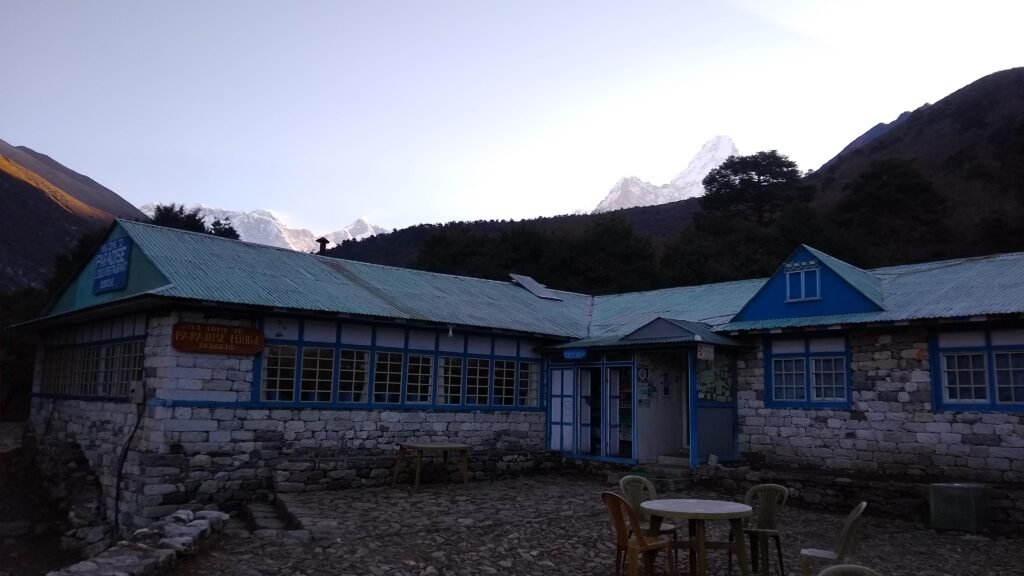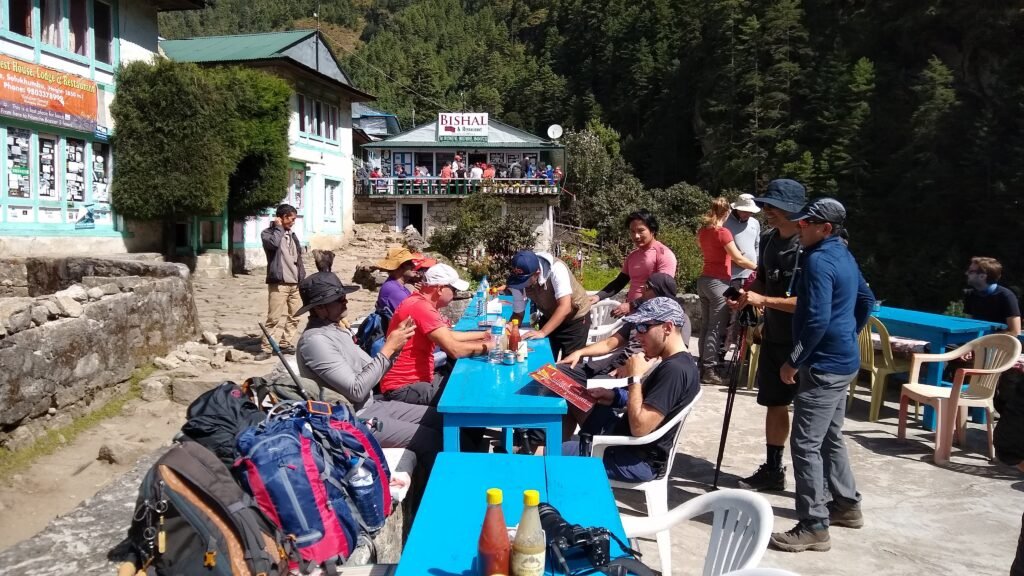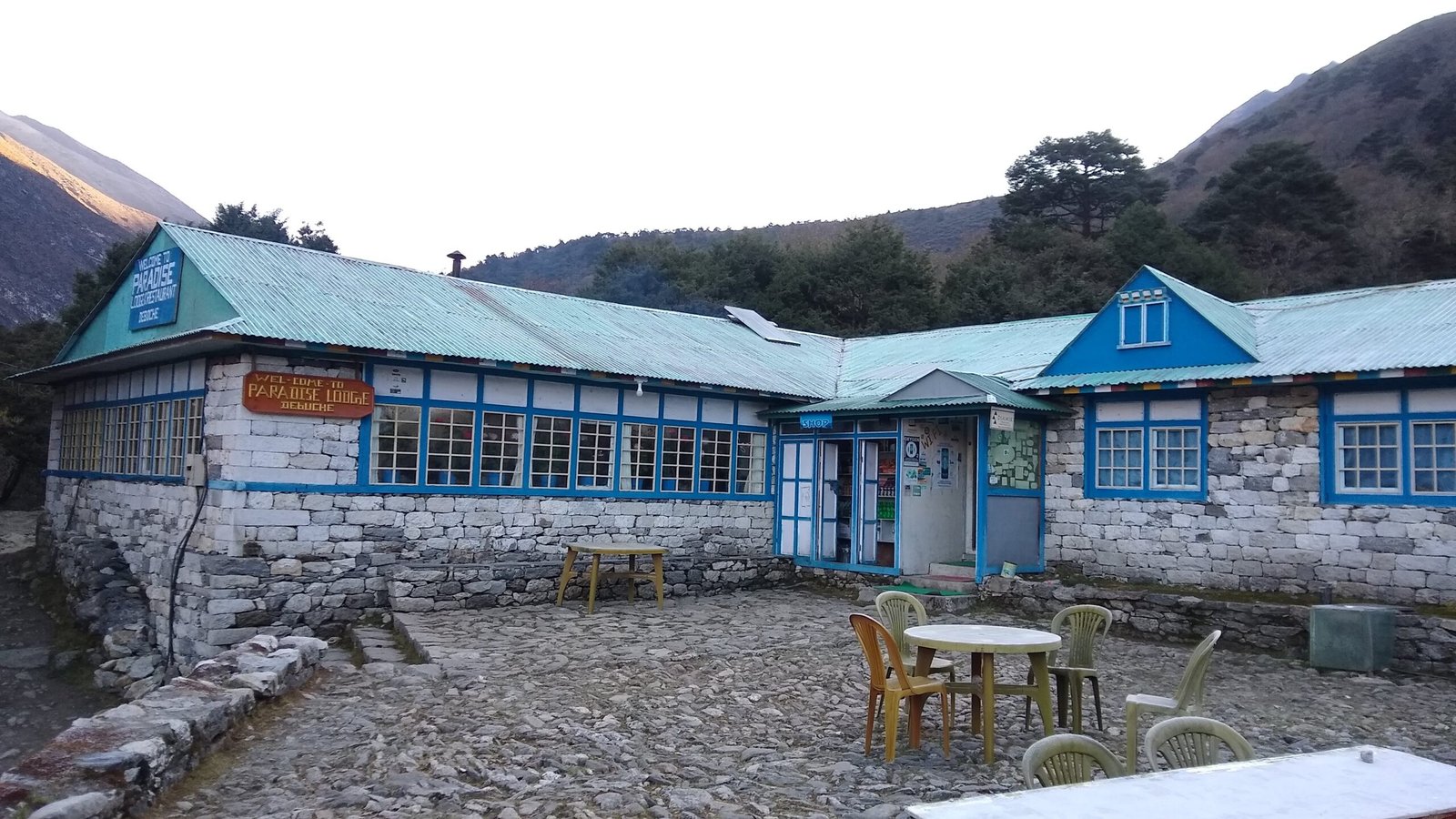What is a Teahouse?
Teahouse trekking refers to staying in a lodge for each night of your trek. Most of the main trekking routes in Everest and Annapurna region in Nepal are teahouse treks, which allow the trekker to travel with the minimum gear and in more comfort.
A teahouse can be a large comfortable lodge with common areas (as found in the Everest Region), to a small bamboo hut lodge within the forest.
Teahouses in Nepal are lodges that are built on the trekking routes like Everest Base Camp and Annapurna region in Nepal that provide both meals and lodging for the trekkers.
Teahouses are different from region to region, but most are simple stone and wooden buildings or huts that have a kitchen, a communal eating hall and bathroom area, and a number of basic bedrooms that usually have two single beds and a table. Most teahouses are built specifically for trekkers.

Teahouse Etiquette
If your accommodation and meals are included as part of a package trek, then everything will be taken care of at your teahouse besides personal snacks and drinks, which you usually pay for yourself. In almost all cases, the cost of your room is very affordable (around $5/night), where the owners make most of their income from the meals for this particular reason, you are expected to eat all your meals at the teahouse at which you’re staying.
Wi-Fi & Electricity
ost of the teahouses in Nepal have wi-fi and charging outlets available in the dining hall. The connection speed and availability are spotty, at best, and slows down the more people that are connected to it. Teahouses in the Everest Base Camptrek have better internet connections (especially in Namche Bazaar), but don’t have high expectations else where in Nepal.
At teahouses, you have to pay to charge your electronic devices. Power outages are quite frequent so be sure to charge when you get the chance!
Toilets and Washing Facilities
In most of the teahouses the toilets are basic. Sometimes very basic! This is obvious given the locations these mountain lodges are in. They will usually have very basic plumbing and a limited water supply which probably comes from a mountain stream. It is, if you think about it like that, amazing how good they actually are!
The toilets will often be squat toilets and sometimes western style sit toilets. The staff do a great job of keeping things clean.
It is also likely that some fellow trekkers have dodgy bowels and you might be visiting the loo straight after them. The toilets might have a flush system, but normally there will be a drum of water and a small jug at the side. The technique is to pour a few buckets into the toilet bowl to flush it.
It is important to not put items like toilet paper and sanitary products down the toilet as they can soon get blocked. There will be a bin in the cubicle for that purpose. On that note, toilet paper is very rarely provided and so keep a stash on hand.
There will often be a few sinks and cold running water, but sometimes not. Again, there may be showers as well (but not always) and they are usually gas heated. You will have to pay for these and there are often only a few. Be prepared to wait your turn. All in all, the washing and toilet facilities will be basic compared to what you are used too.

Food in Tea Teahouse
he food at teahouses is usually varied and nutritious. The choices on the menu are often dictated by what is grown locally. Potato dishes or eggs, for example, are staple choices everywhere. For breakfast you can have everything from pancakes to porridge. For lunch most people stop in one of the many trailside teahouses along the journey.
The menus will often feature western style choices like pizza. In my opinion it pays to consider going with local food choices and with vegetarian options whilst on the trail.
I suggest vegetarian simply because it is hard for meat to be stored hygienically and it’s never possible to know how fresh it is. I suggest local because I think you get more food. Also, as good as the cooks are, it seems to me that they really know their stuff with the local dishes.
Of course, the classic choice in Nepal is the Dahl Bhat and this is a delicious, nutritious and filling choice. It is also very likely that if you choose this you’ll be offered top ups of rice and dahl. Extra portions are very welcome after a draining day on the trail.
Teahouses will usually stock various snack bars and the inevitable tubes of Pringles. There are also soft drinks and alcohol. The prices rise as you get further into the mountains and access for the porter or Yak deliveries is harder. They still remain good value when you consider where you are.

Different Types of Tea Houses in Everest Base Camp Trekking
Everest Base Camp trekking is one of the most popular treks in Nepal. It offers stunning views of the world’s highest mountain, Everest, and other Himalayan peaks, as well as a rich cultural and natural diversity.
One of the main attractions of the trek is the experience of staying in tea houses along the way. Tea houses are small lodges that provide accommodation and food for trekkers. They are run by local people who are friendly and hospitable. Tea houses vary in quality, comfort, and price depending on the location and altitude.
Here are some of the different types of tea houses you can find in Everest Base Camp trekking:
Basic Tea Houses
Basic tea houses are the most common and cheapest option for trekkers. They are usually found in lower altitudes, such as Lukla, Phakding, Namche Bazaar, and Tengboche. Basic tea houses have simple rooms with two or three beds, a shared bathroom, and a common dining area. The food is mostly Nepali cuisine, such as dal bhat (rice and lentils), momo (dumplings), noodles, and soup. The facilities are basic, but they are clean and cozy.
Deluxe Tea Houses
Deluxe tea houses are more comfortable and expensive than basic tea houses. They are usually found in higher altitudes, such as Dingboche, Lobuche, Gorakshep. Deluxe tea houses have spacious rooms with attached bathrooms, hot showers, and Wi-Fi. The food is more varied and includes continental, Chinese, Indian, and Tibetan dishes. The facilities are modern and well-maintained.
Luxury Tea Houses
Luxury tea houses are the most luxurious and exclusive option for trekkers. They are only available in a few places, such as Lukla, Namche Bazaar, and Monjo. Luxury tea houses have elegant rooms with king-sized beds, private bathrooms, bathtubs, heaters, and TV. The food is gourmet and includes international cuisines, such as Italian, French, and Japanese. The facilities are state-of-the-art and include spa, sauna, gym, bar, and library.
Conclusion
Tea houses are an integral part of Everest Base Camp trekking. They offer a unique opportunity to interact with the local culture and enjoy the hospitality of the Sherpa people. Depending on your budget and preference, you can choose from different types of tea houses that suit your needs and expectations.
Best Nepal Tea House Treks in Nepal.
1)Everest Base Camp
2) Annapurna Base Camp
3) Annapurna Circuit
4) Khopra Danda Trek
5) Manaslu Trek


